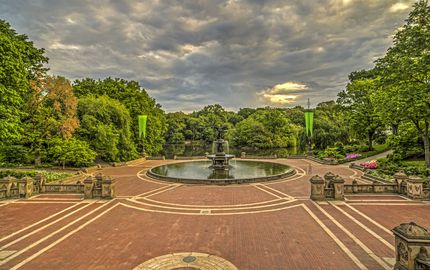

The Bethesda complex takes its name from the Pool of Bethesda, the ancient pool in Jerusalem mentioned in the Gospel of John that healed the sick people who entered it. The word 'bethesda' itself, strangely, has two meanings in Hebrew: house of mercy and disgrace.
The Bethesda Terrace is actually the crowning climax of a bigger structure known as the Central Park Mall, a long elegant promenade lined with shady benches and statues of famous poets. The Mall and the Terrace are divided by Terrace Drive, a road that cuts horizontally through the park from East 72nd Street to West 72nd Street.
The lower level of the terrace, on which stands the Bethesda Fountain and which overlooks the Lake, is made of the reddish New Brunswick sandstone, blending perfectly with the landscape during the autumn season, when the foliage vividly changes colors. This so-called observation deck is outlined by a three-foot-high wall that separates the terrace from the surrounding lawns.
The center of attraction of this deck is the bronze sculpture depicting an angel alighting on the fountain's waters. It was created in the end of the 19th century by Emma Stebbins, the first woman to receive a public commission in New York City. The statue stands eight feet high on a platform, which emits water into the ground basin and under which four cherubs look out in all directions. The cherubs embody Peace, Health, Purity and Temperance. If one looks closely into the basin, he will see a good number of busy turtles swimming around the water lilies, lotus and papyrus. The basin itself was designed by renowned 19th-century British-American architect and landscape designer Calvert Vaux, who, along with architect Frederick Law Olmsted, was responsible for the entire layout of Central Park.
Standing on the edge and looking out onto the lake, to the right we can see the Loeb Central Park Boathouse and Restaurant. It is there that you can rent a boat and navigate the lake, admiring the landscape from the water. There is also a gondolier who offers exotic gondola rides, though this service is not as regular as the traditional rowing boats.
The Bethesda complex is also connected to the Mall by a passage that runs under the Terrace Drive. In fact, upon finishing the Mall walkway, one can either cross the drive and take the staircase down to the lower level deck with the fountain or go down the steps right before the drive and take the passage leading to the deck. The passage is illuminated and is decorated with arcs and elaborate tile work.
The Bethesda Fountain, besides having been an important meeting point for the 60s and 70s hippie generations, has also been a setting for scenes in numerous books and films. Famous movies such as Mel Brook's The Producers, the film adaptation Godspell, Ransom starring Mel Gibson and the TV series Angels in America all have scenes in which the fountain plays an important, if not even metaphorical, role. The Bethesda Fountain also served as a location in the 1975 historical novel Ragtime, by American writer Doctorow, a novel that Time Magazine has listed as one of the 100 best English-language novels of the 20th century. In the novel a character by the name of Younger Brother often comes to the fountain to meet prostitutes, something that today, after Rudolph Giuliani's two terms as New York City Mayor in the 1990s, would be completely unrealistic.